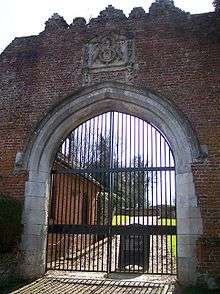Basing House

Basing House was a major Tudor palace and castle in the village of Old Basing in the English county of Hampshire. It once rivaled Hampton Court Palace in its size and opulence. Today only its foundations and earthworks remain. The ruins are a Grade II listed building and a Scheduled Ancient Monument.[1]
History
Basing House was built from 1531 as a new palace for William Paulet, 1st Marquess of Winchester, treasurer to King Edward VI, Queen Mary I and Queen Elizabeth I.
In its final form, Basing House was made up of two linked houses. The Old House replaced the keep of an older ringwork castle,[2] so was located within a defensive ring of earthworks and walls, whilst the slightly later New House was located outside the defences. A bridge and gateway linked the two across and through the defences, a link that was to prove fatal in the final battle for Basing House. Taken together, the house had 360 rooms, was five storeys high and was considered by many to be the greatest private house in the country.
For the first half of the 1630s, the house was shut up and the windows boarded over, while the family decamped to other houses held by the family. The 4th Marquess' entertainments almost bankrupted the family, maintenance of the house fell behind, and the design of such a large brick built (and somewhat experimental) complex after one hundred years had its problems with dry and wet rot, broken windows, leaking roofs, and keeping the various wings heated. On taking the title the 5th Marquess down-sized, moved the family out, and waited until returns from the extensive estates all over England allowed him to start restorations later in the decade.
At the time of the outbreak of the English Civil War in 1642, Basing House belonged to John Paulet, 5th Marquess of Winchester, who was a supporter of King Charles I. As a consequence, parliamentary forces invested Basing House on three different occasions, with the Royalists successfully breaking the first two sieges.
The final siege started in August 1645 when Colonel John Dalbier, with 800 troops, took up position around the walls. The garrison held out, despite further reinforcements to the attacking force, until Oliver Cromwell arrived with a heavy siege-train. By 13 October 1645, the New House had been taken and the defences of the Old House breached. The final storming took place across the link from the New House. Many valuable goods were carried off, and a fire destroyed the building. As with other houses and castles destroyed at the time, its dressed stone was sold off at auction.
Local villagers were encouraged to remove bricks from Basing House, and these materials were reused in homes in the surrounding area. While the local populace would sometimes be used to dismantle buildings, it was unusual to encourage them to make use of the materials.[3]
John Paulet had his estates confiscated and was sent to the Tower of London on a charge of high treason, although these charges were later dropped, and the site of Basing House was returned to him by King Charles II. His son Charles Paulet, 1st Duke of Bolton, became wealthy again as a consequence of his support for William of Orange during the Glorious Revolution. This wealth was used to hack down what was left of Basing House and to build a new house at Hackwood.[4] The history of the area on which the house stands has an unclear history before the house's construction.
Location
Basing House is located in the village of Old Basing, approximately one mile east of the centre of the town of Basingstoke, in the north of the English county of Hampshire. The house is situated close to the upper reaches of the River Loddon. Because of this congestion in Old Basing, the car park for the house is situated several hundred yards away and is accessed by an attractive riverside walk.
The route of the former Basingstoke Canal also ran around Basing House and then through and around parts of Old Basing.
Access
The extensive ruins of Basing House are open to the public. Entry to the House has been significantly altered, with a ticket office, coffee shop and exhibition in an Annex of the Great Barn. Visitors are streamed into the site from the car park, via a short walk along the River Loddon. A UK Heritage Lottery Funded scheme has supported significant upgrades and renovations in recent years.
References
- ↑ Images of England: Basing House Ruins, English Heritage, archived from the original on 2012-10-22, retrieved 2007-12-17
- ↑ "Basing House". Hampshire Cultural Trust. Archived from the original on 2015-07-15.
- ↑ Rakoczy, Lila (2007), Archaeology of destruction: a reinterpretation of castle slightings in the English Civil War, University of York (PhD thesis), p. 121

- ↑ CAP Studios staff (2012), Hackwood House, CAP Studios
External links
- Basing House – on the Hampshire Cultural Trust website
- The story of the Basing House siege
- Sir Stephen Hawkins Regiment of Foote Sealed Knot Regiment who perform an annual re-enactment of the siege of Basing House
- Map sources for Basing House
Coordinates: 51°16′07″N 1°03′09″W / 51.26872°N 1.05248°W
- The Marquess of Winchesters Regiment of the English Civil War Society who reenact the regiment based at Basing House during the English Civil War.
- Time Team Search for the second Basing House Channel 4's Time Team's excavation of the Basing House area.
